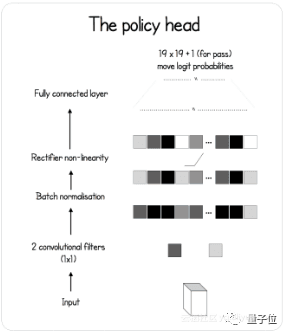遙想當年,AlphaGo的Master版本,在完勝柯潔九段之後不久,就被後輩AlphaGo Zero (簡稱狗零) 擊潰了。
從一隻完全不懂圍棋的AI,到打敗Master,狗零隻用了21天。
而且,它不需要用人類知識來喂養,成為頂尖棋手全靠自學。
如果能培育這樣一隻AI,即便自己不會下棋,也可以很驕傲吧。
于是,來自巴黎的少年Dylan Djian (簡稱小笛) ,就照着狗零的論文去實作了一下。

他給自己的AI棋手起名SuperGo,也提供了代碼 (傳送門見文底) 。
除此之外,還有教程——
一個身子兩個頭
智能體分成三個部分:
一是特征提取器 (Feature Extractor) ,二是政策網絡 (Policy Network) ,三是價值網絡 (Value Network) 。
于是,狗零也被親切地稱為“雙頭怪”。特征提取器是身子,其他兩個網絡是腦子。
特征提取器
特征提取模型,是個殘差網絡 (ResNet) ,就是給普通CNN加上了跳層連接配接 (Skip Connection) , 讓梯度的傳播更加通暢。
1class BasicBlock(nn.Module):
2 """
3 Basic residual block with 2 convolutions and a skip connection
4 before the last ReLU activation.
5 """
6
7 def __init__(self, inplanes, planes, stride=1, downsample=None):
8 super(BasicBlock, self).__init__()
9
10 self.conv1 = nn.Conv2d(inplanes, planes, kernel_size=3,
11 stride=stride, padding=1, bias=False)
12 self.bn1 = nn.BatchNorm2d(planes)
13
14 self.conv2 = nn.Conv2d(planes, planes, kernel_size=3,
15 stride=stride, padding=1, bias=False)
16 self.bn2 = nn.BatchNorm2d(planes)
17
18
19 def forward(self, x):
20 residual = x
21
22 out = self.conv1(x)
23 out = F.relu(self.bn1(out))
24
25 out = self.conv2(out)
26 out = self.bn2(out)
27
28 out += residual
29 out = F.relu(out)
30
31 return out
然後,把它加到特征提取模型裡面去:
1class Extractor(nn.Module):
2 def __init__(self, inplanes, outplanes):
3 super(Extractor, self).__init__()
4 self.conv1 = nn.Conv2d(inplanes, outplanes, stride=1,
5 kernel_size=3, padding=1, bias=False)
6 self.bn1 = nn.BatchNorm2d(outplanes)
7
8 for block in range(BLOCKS):
9 setattr(self, "res{}".format(block), \
10 BasicBlock(outplanes, outplanes))
11
12
13 def forward(self, x):
14 x = F.relu(self.bn1(self.conv1(x)))
15 for block in range(BLOCKS - 1):
16 x = getattr(self, "res{}".format(block))(x)
17
18 feature_maps = getattr(self, "res{}".format(BLOCKS - 1))(x)
19 return feature_maps
政策網絡
政策網絡就是普通的CNN了,裡面有個批量标準化 (Batch Normalization) ,還有一個全連接配接層,輸出機率分布。
<p style="text-align:center"></p>
1class PolicyNet(nn.Module):
2 def __init__(self, inplanes, outplanes):
3 super(PolicyNet, self).__init__()
4 self.outplanes = outplanes
5 self.conv = nn.Conv2d(inplanes, 1, kernel_size=1)
6 self.bn = nn.BatchNorm2d(1)
7 self.logsoftmax = nn.LogSoftmax(dim=1)
8 self.fc = nn.Linear(outplanes - 1, outplanes)
9
10
11 def forward(self, x):
12 x = F.relu(self.bn(self.conv(x)))
13 x = x.view(-1, self.outplanes - 1)
14 x = self.fc(x)
15 probas = self.logsoftmax(x).exp()
16
17 return probas
價值網絡
這個網絡稍微複雜一點。除了标配之外,還要再多加一個全連接配接層。最後,用雙曲正切 (Hyperbolic Tangent) 算出 (-1,1) 之間的數值,來表示目前狀态下的赢面多大。
代碼長這樣——
1class ValueNet(nn.Module):
2 def __init__(self, inplanes, outplanes):
3 super(ValueNet, self).__init__()
4 self.outplanes = outplanes
5 self.conv = nn.Conv2d(inplanes, 1, kernel_size=1)
6 self.bn = nn.BatchNorm2d(1)
7 self.fc1 = nn.Linear(outplanes - 1, 256)
8 self.fc2 = nn.Linear(256, 1)
9
10
11 def forward(self, x):
12 x = F.relu(self.bn(self.conv(x)))
13 x = x.view(-1, self.outplanes - 1)
14 x = F.relu(self.fc1(x))
15 winning = F.tanh(self.fc2(x))
16 return winning
未雨綢缪的樹
狗零,還有一個很重要的組成部分,就是蒙特卡洛樹搜尋 (MCTS) 。
它可以讓AI棋手提前找出,勝率最高的落子點。
在模拟器裡,模拟對方的下一手,以及再下一手,給出應對之策,是以提前的遠不止是一步。
節點 (Node)
樹上的每一個節點,都代表一種不同的局勢,有不同的統計資料:
每個節點被經過的次數n,總動作值w,經過這一點的先驗機率p,平均動作值q (q=w/n) ,還有從别處來到這個節點走的那一步,以及從這個節點出發、所有可能的下一步。
1class Node:
2 def __init__(self, parent=None, proba=None, move=None):
3 self.p = proba
4 self.n = 0
5 self.w = 0
6 self.q = 0
7 self.children = []
8 self.parent = parent
9 self.move = move
部署 (Rollout)
第一步是PUCT (多項式上置信樹) 算法,選擇能讓PUCT函數 (下圖) 的某個變體 (Variant) 最大化,的走法。
寫成代碼的話——
1def select(nodes, c_puct=C_PUCT):
2 " Optimized version of the selection based of the PUCT formula "
3
4 total_count = 0
5 for i in range(nodes.shape[0]):
6 total_count += nodes[i][1]
7
8 action_scores = np.zeros(nodes.shape[0])
9 for i in range(nodes.shape[0]):
10 action_scores[i] = nodes[i][0] + c_puct * nodes[i][2] * \
11 (np.sqrt(total_count) / (1 + nodes[i][1]))
12
13 equals = np.where(action_scores == np.max(action_scores))[0]
14 if equals.shape[0] > 0:
15 return np.random.choice(equals)
16 return equals[0]
結束 (Ending)
選擇在不停地進行,直至到達一個葉節點 (Leaf Node) ,而這個節點還沒有往下生枝。
1def is_leaf(self):
2 """ Check whether a node is a leaf or not """
3
4 return len(self.children) == 0
到了葉節點,那裡的一個随機狀态就會被評估,得出所有“下一步”的機率。
所有被禁的落子點,機率會變成零,然後重新把總機率歸為1。
然後,這個葉節點就會生出枝節 (都是可以落子的位置,機率不為零的那些) 。代碼如下——
1def expand(self, probas):
2 self.children = [Node(parent=self, move=idx, proba=probas[idx]) \
3 for idx in range(probas.shape[0]) if probas[idx] > 0]
更新一下
枝節生好之後,這個葉節點和它的媽媽們,身上的統計資料都會更新,用的是下面這兩串代碼。
1def update(self, v):
2 """ Update the node statistics after a rollout """
3
4 self.w = self.w + v
5 self.q = self.w / self.n if self.n > 0 else 0
1while current_node.parent:
2 current_node.update(v)
3 current_node = current_node.parent
選擇落子點
模拟器搭好了,每個可能的“下一步”,都有了自己的統計資料。
按照這些資料,算法會選擇其中一步,真要落子的地方。
選擇有兩種,一就是選擇被模拟的次數最多的點。試用于測試和實戰。
另外一種,随機 (Stochastically) 選擇,把節點被經過的次數轉換成機率分布,用的是以下代碼——
1total = np.sum(action_scores)
2probas = action_scores / total
3move = np.random.choice(action_scores.shape[0], p=probas)
後者适用于訓練,讓AlphaGo探索更多可能的選擇。
三位一體的修煉
狗零的修煉分為三個過程,是異步的。
一是自對弈 (Self-Play) ,用來生成資料。
1def self_play():
2 while True:
3 new_player, checkpoint = load_player()
4 if new_player:
5 player = new_player
6
7 ## Create the self-play match queue of processes
8 results = create_matches(player, cores=PARALLEL_SELF_PLAY,
9 match_number=SELF_PLAY_MATCH)
10 for _ in range(SELF_PLAY_MATCH):
11 result = results.get()
12 db.insert({
13 "game": result,
14 "id": game_id
15 })
16 game_id += 1
二是訓練 (Training) ,拿新鮮生成的資料,來改進目前的神經網絡。
1def train():
2 criterion = AlphaLoss()
3 dataset = SelfPlayDataset()
4 player, checkpoint = load_player(current_time, loaded_version)
5 optimizer = create_optimizer(player, lr,
6 param=checkpoint['optimizer'])
7 best_player = deepcopy(player)
8 dataloader = DataLoader(dataset, collate_fn=collate_fn, \
9 batch_size=BATCH_SIZE, shuffle=True)
10
11 while True:
12 for batch_idx, (state, move, winner) in enumerate(dataloader):
13
14 ## Evaluate a copy of the current network
15 if total_ite % TRAIN_STEPS == 0:
16 pending_player = deepcopy(player)
17 result = evaluate(pending_player, best_player)
18
19 if result:
20 best_player = pending_player
21
22 example = {
23 'state': state,
24 'winner': winner,
25 'move' : move
26 }
27 optimizer.zero_grad()
28 winner, probas = pending_player.predict(example['state'])
29
30 loss = criterion(winner, example['winner'], \
31 probas, example['move'])
32 loss.backward()
33 optimizer.step()
34
35 ## Fetch new games
36 if total_ite % REFRESH_TICK == 0:
37 last_id = fetch_new_games(collection, dataset, last_id)
訓練用的損失函數表示如下:
1class AlphaLoss(torch.nn.Module):
2 def __init__(self):
3 super(AlphaLoss, self).__init__()
4
5 def forward(self, pred_winner, winner, pred_probas, probas):
6 value_error = (winner - pred_winner) ** 2
7 policy_error = torch.sum((-probas *
8 (1e-6 + pred_probas).log()), 1)
9 total_error = (value_error.view(-1) + policy_error).mean()
10 return total_error
三是評估 (Evaluation) ,看訓練過的智能體,比起正在生成資料的智能體,是不是更優秀了 (最優秀者回到第一步,繼續生成資料) 。
1def evaluate(player, new_player):
2 results = play(player, opponent=new_player)
3 black_wins = 0
4 white_wins = 0
5
6 for result in results:
7 if result[0] == 1:
8 white_wins += 1
9 elif result[0] == 0:
10 black_wins += 1
11
12 ## Check if the trained player (black) is better than
13 ## the current best player depending on the threshold
14 if black_wins >= EVAL_THRESH * len(results):
15 return True
16 return False
第三部分很重要,要不斷選出最優的網絡,來不斷生成高品質的資料,才能提升AI的棋藝。
三個環節周而複始,才能養成強大的棋手。
年幼的SuperGo
小笛用學校的伺服器訓練了AI棋手一星期。
SuperGo還年幼,是在9x9棋盤上訓練的。
小笛說,他的AI現在好像還不懂生死一類的事,但應該已經知道圍棋是個搶地盤的遊戲了。
雖然,沒有訓練出什麼超神的棋手,但這次嘗試依然值得慶祝。
Reddit上面也有同仁發來賀電。
△ 有前途的意思
有志于AI圍棋的各位,也可以試一試這個PyTorch實作。
代碼實作傳送門:
https://github.com/dylandjian/SuperGo教程原文傳送門:
https://dylandjian.github.io/alphago-zero/AlphaGo Zero論文傳送門:
https://www.nature.com/articles/nature24270.epdf